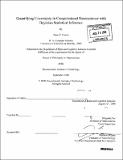| dc.contributor.advisor | Mriganka Sur. | en_US |
| dc.contributor.author | Cronin, Beau D | en_US |
| dc.contributor.other | Massachusetts Institute of Technology. Dept. of Brain and Cognitive Sciences. | en_US |
| dc.date.accessioned | 2009-04-29T17:27:24Z | |
| dc.date.available | 2009-04-29T17:27:24Z | |
| dc.date.copyright | 2008 | en_US |
| dc.date.issued | 2008 | en_US |
| dc.identifier.uri | http://hdl.handle.net/1721.1/45336 | |
| dc.description | Thesis (Ph. D.)--Massachusetts Institute of Technology, Dept. of Brain and Cognitive Sciences, 2008. | en_US |
| dc.description | Includes bibliographical references (p. 101-106). | en_US |
| dc.description.abstract | Two key fields of computational neuroscience involve, respectively, the analysis of experimental recordings to understand the functional properties of neurons, and modeling how neurons and networks process sensory information in order to represent the environment. In both of these endeavors, it is crucial to understand and quantify uncertainty - when describing how the brain itself draws conclusions about the physical world, and when the experimenter interprets neuronal data. Bayesian modeling and inference methods provide many advantages for doing so. Three projects are presented that illustrate the advantages of the Bayesian approach. In the first, Markov chain Monte Carlo (MCMC) sampling methods were used to answer a range of scientific questions that arise in the analysis of physiological data from tuning curve experiments; in addition, a software toolbox is described that makes these methods widely accessible. In the second project, the model developed in the first project was extended to describe the detailed dynamics of orientation tuning in neurons in cat primary visual cortex. Using more sophisticated sampling-based inference methods, this model was applied to answer specific scientific questions about the tuning properties of a recorded population. The final project uses a Bayesian model to provide a normative explanation of sensory adaptation phenomena. The model was able to explain a range of detailed physiological adaptation phenomena. | en_US |
| dc.description.statementofresponsibility | by Beau D. Cronin. | en_US |
| dc.format.extent | 106 p. | en_US |
| dc.language.iso | eng | en_US |
| dc.publisher | Massachusetts Institute of Technology | en_US |
| dc.rights | M.I.T. theses are protected by
copyright. They may be viewed from this source for any purpose, but
reproduction or distribution in any format is prohibited without written
permission. See provided URL for inquiries about permission. | en_US |
| dc.rights.uri | http://dspace.mit.edu/handle/1721.1/7582 | en_US |
| dc.subject | Brain and Cognitive Sciences. | en_US |
| dc.title | Quantifying uncertainty in computational neuroscience with Bayesian statistical inference | en_US |
| dc.type | Thesis | en_US |
| dc.description.degree | Ph.D. | en_US |
| dc.contributor.department | Massachusetts Institute of Technology. Department of Brain and Cognitive Sciences | |
| dc.identifier.oclc | 315901857 | en_US |
